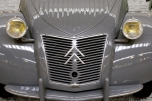Cars after 1950 - Modern Times
Mercedes Type 300 SL
1955
Code 1609
Body style: coupé
From its very earliest days, Daimler-Benz’s policy had always been to only enter races if it had a good chance of winning. They were proved right in 1908, 1914, 1935, 1938, 1939 and other triumphant years. Things were hardly going to be any different when Daimler-Benz returned to competition in 1952 after the wartime break. Just one year after the launch of the very modern Type 220 and 300 six-cylinder model, Mercedes had perfected its weapon: a sleek coupé, the 300 SL. The Daimler-Benz approach helped the 300 SL to win all the major competitions in 1952. It was second and fourth in the Mille Miglia, won the Swiss Grand Prix and then went on, a few weeks later, to score a one-two in the 24 Hours of Le Mans, before taking the top three places at the Nürburgring. In November of the same year, it took the crown in the formidable Carrera Panamericana, a 3100 km (1900 mile) race through the mountains and deserts of Mexico. This, despite the fact that one of the two drivers, Hans Klenk was briefly knocked unconscious by a vulture towards the beginning of the race. The racing victories and the universally recognised attractive shape of the car meant that commercial success was assured when series production commenced.
The engine, was derived from the 300 S, with a 50° cant and a direct injection system. However, the chassis of the car was completely revolutionary. It was built of multiple lightweight tubes welded together, making the 300 SL lighter and stronger than anything previously seen. This structure rose very high on the side of the car, which was why the doors opened upwards, in the “gull wing” style.
It also boasted a range of exceptional technical features, including a typically “Mercedes” independent double-wishbone front suspension and excellent rear suspension, power drum brakes, a Bosch six-cylinder direct injection engine, which generated 215 hp and drove the 300 SL to speeds of 240 kph (150 mph), making it the fastest series-produced car in the world. Its acceleration from 0 to 100 kph (62 mph) took only 7 seconds.
Production came to an end in the early 1960s and the Mercedes 300 SL has remained one of the most famous cars of all time and a collectors’ favourite. The car on display at the Cité de l’Automobile was used by Fritz Schlumpf for many years.























